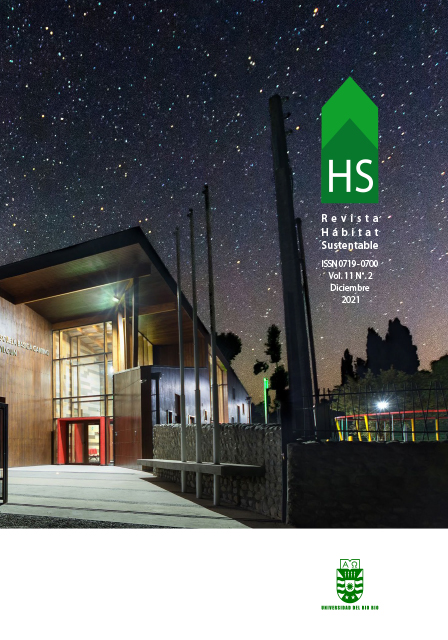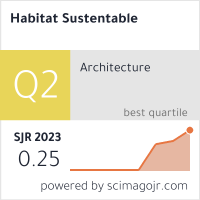El rol activo del usuario en la búsqueda de confort térmico de viviendas en clima templado árido
DOI:
https://doi.org/10.22320/07190700.2021.11.02.01Palabras clave:
uso y gestión, ocupación, comportamiento del usuario, confort térmico, estrategias bioclimáticasResumen
El comportamiento del usuario es uno de los principales factores de incertidumbre en el desempeño térmico de una vivienda. El presente estudio contribuye a identificar variables que influyen en la conducta del usuario y, a su vez, en cómo ésta afecta el desempeño térmico de viviendas en la ciudad de Mendoza. En ese sentido, se realizó una auditoría térmica de una vivienda representativa, en verano e invierno, elaborando en forma paralela un registro de uso y gestión de los habitantes. Se concluye que, en verano, una correcta gestión de la envolvente mediante la ventilación nocturna favorece el logro de confort interior en un 89% de los datos registrados; y, en invierno, un correcto aprovechamiento de la ganancia solar directa favorece el logro de confort en un 60% de dichos datos. Se evalúan, finalmente, alternativas de mejora edilicia para la estación más desfavorable.
Descargas
Citas
ALONSO-FRANK, A. DE LAS P. Y KUCHEN, E. (2016). Desarrollo de una herramienta para validar la influencia del comportamiento del usuario sobre la eficiencia energética en edificios públicos de oficinas. Hábitat Sustentable, 6(2), 62–69. Recuperado de http://revistas.ubiobio.cl/index.php/RHS/article/view/2502
Agencia Internacional de la Energía [IEA] y Programa de las Naciones Unidas para el Medio Ambiente [UNEP] (2019). Global Status Report for Buildings and Construction: Towards a zero-emissions, efficient and resilient buildings and construction sector. UN Enviroment programme, 224. Recuperado de https://www.unep.org/resources/publication/2019-global-status-report-buildings-and-construction-sector
ANDERSEN, R. K., FABI, V. Y CORGNATI, S. P. (2016). Predicted and actual indoor environmental quality: Verification of occupants’ behaviour models in residential buildings. Energy & Buildings, 127, 105–115. DOI: https://doi.org/10.1016/j.enbuild.2016.05.074
ANDREONI TRENTACOSTE, S. E. Y GANEM KARLEN, C. (2017). Influencia del uso y gestión de la envolvente en el comportamiento térmico de verano de una vivienda en la ciudad de Mendoza, Argentina. Hábitat Sustentable, 7(2), 64–75. DOI: https://doi.org/10.22320/07190700.2017.07.02.06
ANTONIADOU, P. Y PAPADOPOULOS, A. M. (2017). Occupants’ thermal comfort: State of the art and the prospects of personalized assessment in office buildings. Energy & Buildings, 153, 136–149. DOI: https://doi.org/10.1016/j.enbuild.2017.08.001
ARRIETA, G. M. (2020). Valoraciones subjetivas y condiciones objetivas de confort térmico en viviendas. Arquitecno, (16), 57-66. DOI: https://doi.org/10.30972/arq.0164553
ASHRAE (2008). ASHRAE. Proposed addendum d to Standard 55-2004, Thermal environmental conditions for human occupancy. Recuperado de http://www/ashrae.org
BALVEDI, B. F., GHISI, E. Y LAMBERTS, R. (2018). A review of occupant behaviour in residential buildings. Energy and Buildings, 174, 495–505. DOI: https://doi.org/10.1016/j.enbuild.2018.06.049
CARLUCCI, S., DE SIMONE, M., FIRTH, S. K., KJÆRGAARD, M. B., MARKOVIC, R., RAHAMAN, M. S., ANNAQEEB, M. K., BIANDRATE, S., DAS, A., DZIEDZIC, J. W., FAJILLA, G., FAVERO, M., FERRANDO, M., HAHN, J., HAN, M., PENG, Y., SALIM, F., SCHLÜTER, A. Y VAN TREECK, C. (2020). Modeling occupant behavior in buildings. Building and Environment, 174. DOI: https://doi.org/10.1016/j.buildenv.2020.106768
CUERDA, E., GUERRA-SANTIN, O. Y NEILA GONZÁLEZ, F. J. (2018). Definiendo patrones de ocupación mediante la monitorización de edificios existentes. Informes de La Construcción, 69(548). DOI: https://doi.org/10.3989/id.53526
D’AMANZO, M., MERCADO, M. V. Y GANEM KARLEN, C. (2020). 10 preguntas de los edificios energía cero: revisión del estado del arte. Hábitat Sustentable, 10(2), 24–41. DOI: https://doi.org/10.22320/07190700.2020.10.02.02
DE SIMONE, M., CARPINO, C., MORA, D., GAUTHIER, S., ARAGON, V. Y HARPUTLUGIL, G. U. (2018). Reference procedures for obtaining occupancy profiles in residential buildings (Issue IEA EBC Annex 66 – Subtask A). Recuperado de http://www.annex66.org/?q=Publication
DEIE (2019). Encuesta condiciones de vida. Informe anual. Recuperado de https://deie.mendoza.gov.ar/#!/repositorio-de-novedades/encuesta-de-condiciones-de-vida-informe-anual-2019-286
DEUBLE, M. P. Y DE DEAR, R. J. (2012). Green occupants for green buildings: The missing link? Building and Environment, 56, 21–27. DOI: https://doi.org/10.1016/j.buildenv.2012.02.029
DIULIO, M. DE LA P., NETTO, G. R., BERARDI, R. Y CZAJKOWSKI, J. D. (2016). Impacto de la envolvente en la demanda de energía en calefacción residencial de la región metropolitana de La Plata, tomando como caso testigo el reciclado energético de una vivienda. Ambiente Construido, 16(1), 55–70. DOI: https://doi.org/10.1590/s1678-86212016000100060
FILIPPÍN, C. Y LARSEN, S. F. (2005). Comportamiento termico de invierno de una vivienda convencional en condiciones reales de uso. Avances en Energías Renovables y Medio Ambiente, 9, 67–72. Recuperado de http://sedici.unlp.edu.ar/handle/10915/82337
FLORES-LARSEN, S., FILIPPÍN, C. Y BAREA, G. (2019). Impact of climate change on energy use and bioclimatic design of residential buildings in the 21st century in Argentina. Energy and Buildings, 184, 216–229. DOI: https://doi.org/10.1016/j.enbuild.2018.12.015
GIVONI, B. (1992). Comfort, climate analysis and building design guidelines. Energy and Buildings, 18(1), 11–23. DOI: https://doi.org/10.1016/0378-7788(92)90047-K
GÖÇER, Ö., CANDIDO, C., THOMAS, L. Y GÖÇER, K. (2019). Differences in occupants’ satisfaction and perceived productivity in high- and low-performance offices. Buildings, 9(9), 14–18. DOI: https://doi.org/10.3390/buildings9090199
HONG, T., YAN, D., D’OCA, S. Y CHEN, C. (2017). Ten questions concerning occupant behavior in buildings: The big picture. Building and Environment, 114, 518–530. DOI: https://doi.org/10.1016/j.buildenv.2016.12.006
INVIDIATA, A. Y GHISI, E. (2016). Impact of climate change on heating and cooling energy demand in houses in Brazil. Energy and Buildings, 130, 20–32. DOI: https://doi.org/10.1016/j.enbuild.2016.07.067
KOTTEK, M., GRIESER, J., BECK, C., RUDOLF, B. Y RUBEL, F. (2006). World map of the Köppen-Geiger climate classification updated. Meteorologische Zeitschrift, 15(3), 259–263. DOI: https://doi.org/10.1127/0941-2948/2006/0130
LI, J., YU, Z., HAGHIGHAT, F. Y ZHANG, G. (2019). Development and improvement of occupant behavior models towards realistic building performance simulation: A review. Sustainable Cities and Society, 50. DOI: https://doi.org/10.1016/j.scs.2019.101685
LOPES, M. A. R., ANTUNES, C. H., REIS, A. Y MARTINS, N. (2017). Estimating energy savings from behaviours using building performance simulations. Building Research & Information, 45(3), 303–319. DOI: https://doi.org/10.1080/09613218.2016.1140000
MARTÍNEZ PERALTA, C. M. (2016). Respuestas urbanas al cambio climático en América Latina. Estudios Sociales. Revista de Alimentación Contemporánea y Desarrollo Regional, 25(47). DOI: https://doi.org/10.24836/es.v25i47.321
National Renewable Energy Laboratory [NREL] (2017). Energy Plus (8.8). Recuperado de https://energyplus.net/downloads
OLGYAY, V. (1998). Arquitectura y clima. Manual de diseño bioclimático para arquitectos y urbanistas. Barcelona: Gustavo Gili.
PALME, M., CARRASCO, C. Y GÁLVEZ, M. Á. (2016). Estimación del riesgo de sobrecalentamiento y del potencial de refrigeración por ventilación natural de viviendas unifamiliares en ciudades costeras de Chile. Hábitat Sustentable, 6(2), 52–61. Recuperado de http://revistas.ubiobio.cl/index.php/RHS/article/view/2621
Panel Intergubernamental del Cambio Climático [IPCC] (2018). Global warming of 1.5°C. An IPCC Special Report on the impacts of global warming of 1.5°C above pre-industrial levels and related global greenhouse gas emission pathways, in the context of strengthening the global response to the threat of climate change. Recuperado de https://www.ipcc.ch/sr15/
Panel Intergubernamental del Cambio Climático [IPCC] (2021). Climate Change 2021: The Physical Science Basis. Contribution of Working Group I to the Sixth Assessment Report of the Intergovernmental Panel on Climate Change [Masson-Delmotte, V., P. Zhai, A. Pirani, S. L. Connors, C. Péan, S. Berger, N. Caud, Y. Chen, L. Goldfarb, M. I. Gomis, M. Huang, K. Leitzell, E. Lonnoy, J.B.R. Matthews, T. K. Maycock, T. Waterfield, O. Yelekçi, R. Yu and B. Zhou (eds.)]. Cambridge University Press. [En prensa]. Recuperado de https://www.ipcc.ch/report/ar6/wg1/downloads/report/IPCC_AR6_WGI_Full_Report_smaller.pdf
PÉREZ, M. (2016). Ecoinvolucrate: Alternativa para la sostenibilidad en la Arquitectura. Estoa., II(V), 29–35. Recuperado de http://192.188.48.56/ojs/index.php/estoa/article/view/619
ROAF, S. (2018). Building resilience in the built environment. En Trogal, K., Bauman, I., Lawrence, R. y Petrescu, D. (Eds.). Architecture and Resilience. Interdisciplinary Dialogues (pp. 143–157). New York: Routledge. DOI: https://doi.org/10.4324/9781315159478-11
SERRA FLORENSA, R. Y COCH ROURA, H. (1991). Arquitectura y energía natural. Barcelona: UPC.
Servicio Meteorológico Nacional [SMN]. (2018) ¿Cómo clasificamos la intensidad del viento? Recuperado de https://www.smn.gob.ar/noticias/¿cómo-clasificamos-la-intensidad-del-viento?fbclid=IwAR0jUzpuWyuO9CN7uEHhsXBXOeHV2y2eUlSkVrypMupDdaWagNofGCzjgWs
SILVA, A. S., ALMEIDA, L. S. S. Y GHISI, E. (2016). Decision-making process for improving thermal and energy performance of residential buildings: A case study of constructive systems in Brazil. Energy and Buildings, 128, 270–286. DOI: https://doi.org/10.1016/j.enbuild.2016.06.084
SOSA, M. B., CORREA, E. Y CANTÓN, M. A. (2016). Morfología urbana y comportamiento térmico de canales viales. Desarrollo de un modelo predictivo para temperaturas máximas. Urbano, 19(33), 66–75. Recuperado de http://revistas.ubiobio.cl/index.php/RU/article/view/2358
STOCCO, S., CANTÓN, M. Y CORREA, É. (2013). Evaluación de las condiciones térmicas de verano y eficiencia ambiental de distintos diseños de plazas urbanas en Mendoza, Argentina. Hábitat Sustentable, 3(2), 19–34. Recuperado de http://revistas.ubiobio.cl/index.php/RHS/article/view/432
WAGNER, A. Y O’BRIEN, W. (2018). Exploring Occupant Behavior in Buildings. Springer International Publishing. DOI: https://doi.org/10.1007/978-3-319-61464-9
Descargas
Publicado
Cómo citar
Número
Sección
Licencia
Derechos de autor 2021 Soledad Elisa Andreoni-Trentacoste, Carolina Ganem-Karlen

Esta obra está bajo una licencia internacional Creative Commons Atribución-CompartirIgual 4.0.
El contenido de los artículos que se publican en cada número de Hábitat Sustentable, es responsabilidad exclusiva de los autores y no representan necesariamente el pensamiento ni comprometen la opinión de la Universidad del Bío-Bío.
Los autores/as conservarán sus derechos de autor y garantizarán a la revista el derecho de primera publicación de su obra, el cuál estará simultáneamente sujeto a la Licencia de Reconocimiento de Creative Commons CC BY-SA que permite a otros compartir-copiar, transformar o crear nuevo material a partir de esta obra con fines no comerciales, siempre y cuando se reconozcan la autoría y la primera publicación en esta revista, y sus nuevas creaciones estén bajo una licencia con los mismos términos.











 Programa de Información Científica/Concurso Fondos de Publicación de Revistas Científicas 2018/ Proyecto Mejoramiento de Visibilidad de Revistas UBB (Código:FP180007)
Programa de Información Científica/Concurso Fondos de Publicación de Revistas Científicas 2018/ Proyecto Mejoramiento de Visibilidad de Revistas UBB (Código:FP180007) 





